225 vs 235 Tires: 8 Differences You Should Know Before Investing
The choice between 225 vs 235 tires can be challenging, as each size comes with its own advantages and disadvantages. Understanding their differences is crucial in determining the best fit for your driving needs.
Let’s delve into the details and unravel eight essential distinctions between these two tires size, and explore the crucial aspects to take into account prior to making a decision!
Table of Contents
235 Tires vs 225 Tires – Overview
These two tires are both popular options for vehicles, with slight differences in their specifications and advantages. The 225 tires are designed to be narrower, resulting in improved fuel efficiency and precise handling.
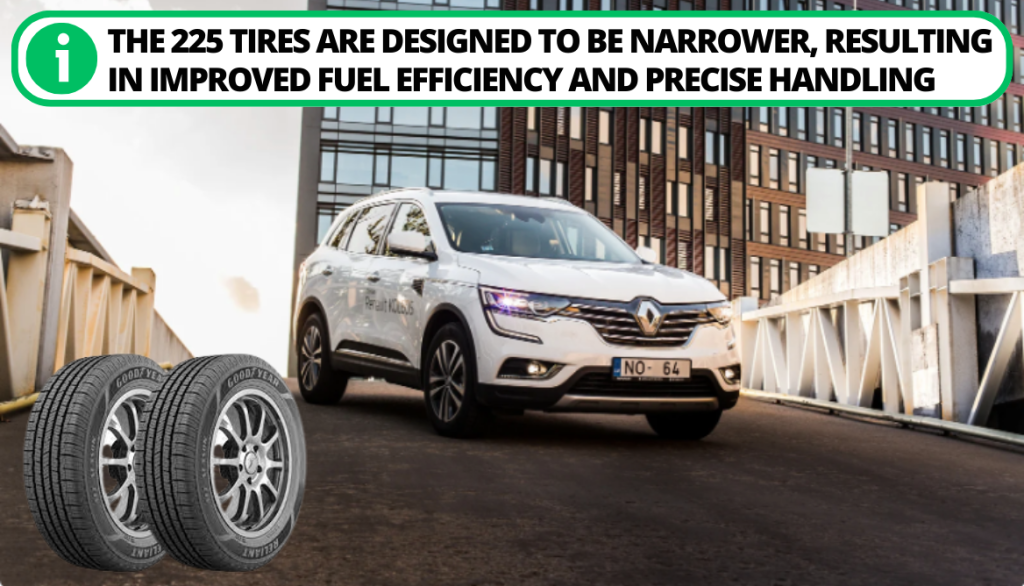
On the other hand, the 235 tires boast a slightly wider profile, offering more traction and stability on the road. The decision between these two types depends on individual preferences and the specific needs of the vehicle in question.
Understanding the Importance of 225 and 235 on Tires
When examining a tire, you will commonly notice two numbers, such as 225 and 235. These numbers signify the tire width in millimeters, specifically measuring the distance from one sidewall to the other at the widest point.
Let’s break down what each number means:
- 225: This number represents the tire width in millimeters. In the case of “225,” it means the tire’s cross-section width is 225 millimeters from sidewall to sidewall when properly inflated and mounted on a specified wheel width.
- 235: Similarly, “235” refers to the tire width in millimeters. A tire labeled with “235” has a cross-section width of 235 millimeters when mounted and inflated correctly on a specified wheel width.

How do these numbers affect your vehicle?
- Tire Fitment: The tire width is crucial for ensuring that the tire fits correctly on the vehicle’s wheel. If the tire width is not appropriate for the wheel size, it can lead to improper handling, compromised performance, and potential safety issues.
- Tire Performance: The tire width can influence the performance characteristics of the tire. Wider tires generally offer better traction and handling, especially in dry conditions. However, they may be more susceptible to hydroplaning on wet roads. On the other hand, narrower tires may provide better grip on icy or snowy surfaces.
- Fuel Efficiency: Wider tires tend to have higher rolling resistance, which can impact fuel efficiency to some extent. Narrower tires may offer slightly better fuel economy.
- Ride Comfort: W=kier tires can improve stability, but they may also result in a slightly harsher ride compared to narrower tires, which can provide more cushioning.
To further illustrate the concept of tire sizes, here are the tables that provides a better explanation:
Size | 225/65R17 | 235/65R17 |
Tire Width: | 225 mm (8.86 inches) | 235 mm (9.25 inches) |
Sidewall Height (Aspect Ratio): | 123.75 mm (4.87 inches) | 129.25 mm (5.09 inches) |
Wheel Diameter: | 17 inches | 17 inches |
Tire Diameter (Height): | 724.3 mm (28.52 inches) | 737.3 mm (29.03 inches) |
Circumference: | 2275.46 mm (89.58 inches) | 2316.3 mm (91.19 inches) |
Revolutions: | 439.47 km (707.26/mile) | 431.72 km |
Parameter | 225 Tires | 235 Tires |
Tire Width: | 225 millimeters | 235 millimeters |
Gas Mileage: | Potential for better mileage | Comparatively lower mileage |
Carload: | Handles lighter loads | Higher load-carrying capacity |
Performance: | Better gas mileage, smoother ride | Enhanced stability, grip |
Grip (Wet/Dry): | Satisfactory performance | Better grip on wet surfaces |
Handling: | Less responsive | Improved cornering stability |
Ride Comfort: | Slightly smoother ride | Slightly firmer ride |
Cost: | Generally less expensive | Comparatively more expensive |
Tire Comparison: Analyzing 225 vs. 235 Tires Across 8 Parameters
There are several parameters to consider when comparing 225 tires and 235 tires. Below is a comprehensive comparison of eight crucial parameters:
1. Tire Width
Tire width plays a pivotal role in shaping a tire’s overall performance and attributes. When comparing these two tires, the key distinction lies in their width—225 tires measure 225, while 235 tires boast a width of 235 millimeters for both cases.
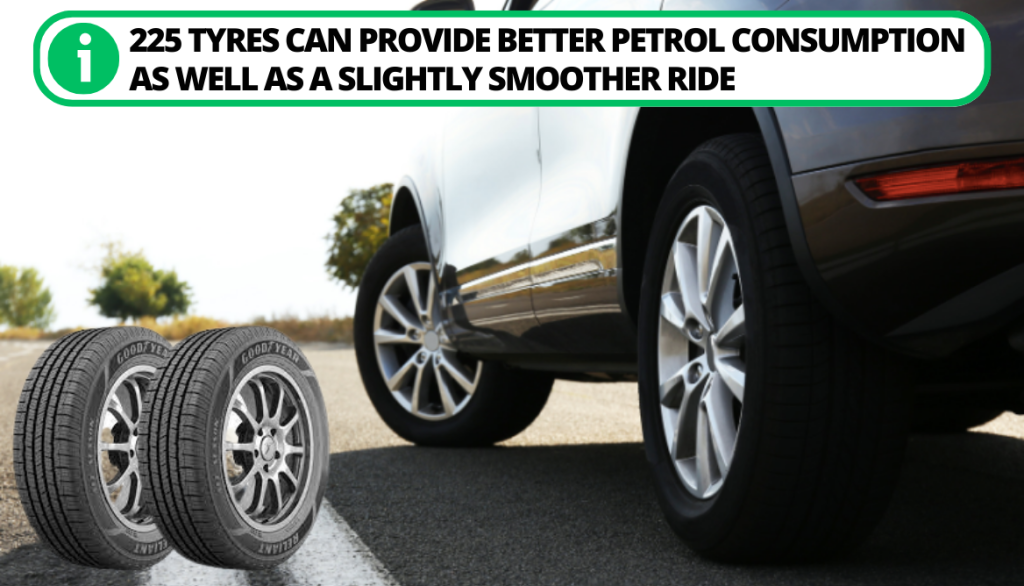
The broader surface area of the 235 tires promises improved stability and exceptional grip, especially on wet road surfaces. Conversely, the 225 tires, being narrower, are known for their potential to deliver better gas mileage while also offering a slightly smoother ride.
Winner: 235 tires have wider width that improves stability and exceptional grip on wet road surfaces.
2. Gas Mileage
225 tires generally provide better gas mileage compared to 235 tires due to their narrower width and lower rolling resistance. The reduced friction and weight of 225 tires result in improved fuel mileage. However, the actual difference in gas mileage may vary depending on driving habits and road conditions.
It is crucial to acknowledge that fuel efficiency can be influenced by various factors, beyond just the type of tire, such as tread design and driving conditions. Hence, consider the overall tire performance and characteristics when evaluating fuel mileage.
Winner: 225 provide better gas mileage due to its narrower width and rolling resistance.
3. Carload
When comparing tires with sizes One crucial factor to consider when comparing tires with sizes 225 and 235 tires typically boast a higher load-carrying capacity compared to 225 tires, which are better suited for lighter loads.
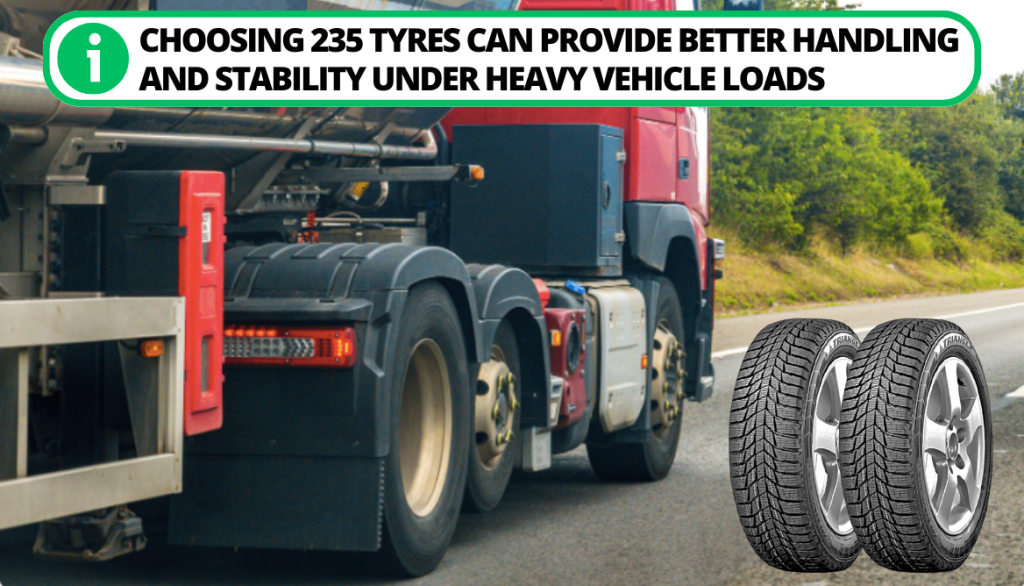
If you frequently carry heavy loads or own a larger vehicle, choosing 235 tires can offer better handling and stability when dealing with increased carload conditions.
Winner: The 235 tires rank higher since they are designed to carry heavy loads.
4. Performance
In a comparison between 225 and 235 tires, the 235 tires exhibit a wider footprint, providing them with superior wet, snow, and ice braking capabilities compared to the 225 tires. On the other hand, due to its narrower footprint, the 225-width tire offers better gas mileage and a slightly smoother ride when compared to the 235-width tire.
Winner: The 235 tires are the winner here since they can perform on wet, snow, and icy roads.
5. Grip (Wet and Dry Conditions)
The grip is a critical factor to consider when comparing 225 tires and 235 tires, particularly in wet and dry conditions. A wider tire, such as the 235s, inherently offers superior grip due to its larger contact patch. enhancing better traction, especially on wet roads, ensuring safer and more confident handling.

However, under dry conditions, the variance in grip between the two tire sizes might be less pronounced as both can deliver satisfactory performance.
Winner: The 235 tires rank higher because they are wider and have a larger contact patch.
6. Handling
Handling is an important aspect to consider when comparing 225 tires and 235 tires. Wider tires like the 235s generally offer improved handling capabilities due to their larger contact patch, enhancing cornering stability and responsiveness.
However, the specific handling characteristics can also depend on factors such as tire construction, tread design, and rubber compound. Hence, it’s important to consider these factors alongside tire width when evaluating handling performance.
Winner: 235 tires rank higher due to their larger contact patch.
7. Ride Comfort
Ride comfort is a crucial consideration when comparing 225 and 235 tires. Narrower tires like the 225s provide a slightly smoother and more comfortable ride because they are mostly found in compact cars. In contrast, wider tires like the 235s may transmit more road imperfections to the vehicle’s occupants, resulting in a slightly firmer ride.

It’s important to note that ride comfort can also be influenced by factors such as tire construction, sidewall design, and overall suspension setup.
Winner: The 225 tires outperform due to their narrower tires.
8. Cost
Cost is an important factor to consider when comparing 225 and 235 tires. Generally, 225 tires are slightly less expensive than their 235 tires counterparts due to their smaller size and are mostly used in light vehicles.
However, it’s worth noting that tire costs can vary based on:
- The brand;
- Model;
- Specific features.
So it’s advisable to compare prices and consider the overall value and performance of the tires rather than solely focusing on the initial cost.
Additionally, it’s important to factor in the long-term cost, including tire lifespan and potential more fuel efficiency differences, when evaluating the cost-effectiveness of 225 and 235 tires.
Winner: The 225 tires are less expensive due to their smaller size and are mostly used in light vehicles.
10 Essential Tips for Choosing New Tires
Selecting the appropriate tires for your vehicle is of utmost importance, as it directly impacts crucial aspects such as safety, performance, and overall driving comfort. Here are some factors to consider when choosing new tires:
1. Consider Your Vehicle’s Specifications
Refer to the vehicle’s owner’s manual or seek advice from a reliable mechanic to find the recommended tire size for your car. This information will be invaluable in helping you make an informed decision when choosing the right tires for your vehicle.
2. Understand Tire Sizing
Tires are identified by a series of numbers, such as 225/45R17:
- The first number (225) represents the tire’s width in millimeters indicating how wide the tire is.
- The second number (45) represents the aspect ratio, which is the sidewall’s height as a percentage of the tire’s width.
In this case, a 225 tire would be narrower than a 235 tire.
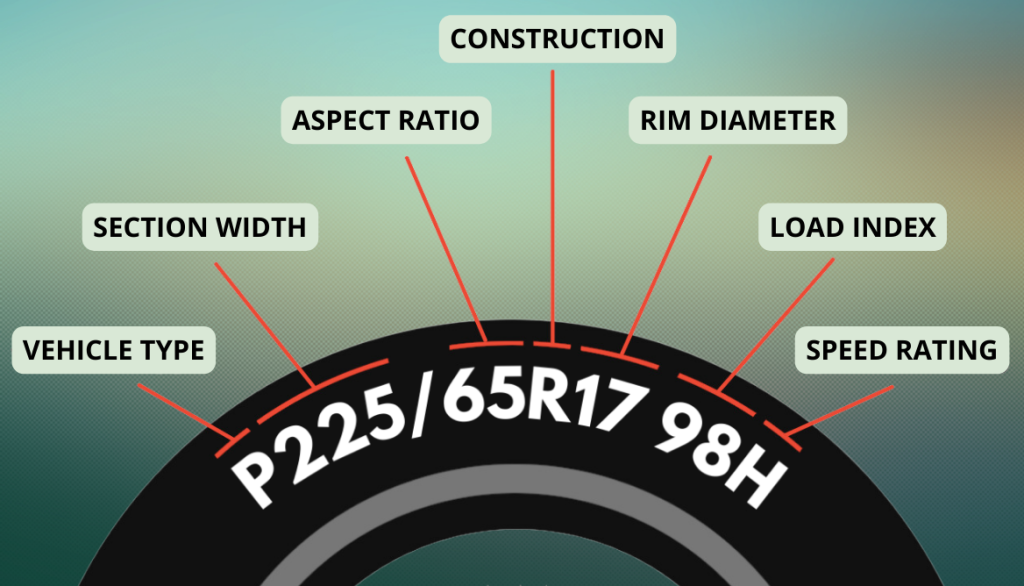
3. Assess Your Driving Needs
Consider your driving habits and the conditions in which you typically drive. In your typical driving scenario, do you find yourself predominantly on highways or city streets? Moreover, are you often faced with driving on wet or snowy roads? Understanding your driving needs will help you determine your situation’s ideal tire size and type.
4. Evaluate Performance Characteristics
Big tread blocks in 235 tires enhance better handling and stability, ideal for larger vehicles, while narrower tires like 225 can improve fuel efficiency and offer a smoother ride. The choice between these sizes depends on your specific vehicle and performance preferences. Think about your priorities and preferences regarding handling, comfort, and efficiency.
5. Check Compatibility and Clearance
Ensure your tire size matches your vehicle’s wheel size and suspension system. Additionally, consider any potential clearance issues, especially considering larger tire sizes. You don’t want the tires rubbing against the wheel well or other parts of your vehicle.
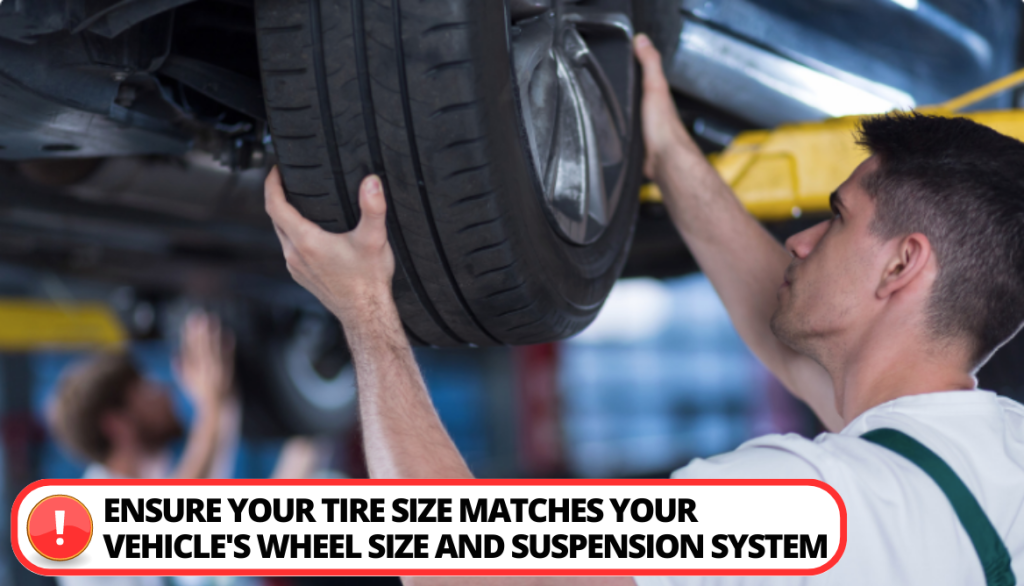
6. Consider Cost and Availability
Compare the prices and availability of tires in different sizes. Sometimes, certain tire sizes may be more popular and thus more readily available and affordable. Keep your budget in mind while making your decision.
7. Seek Professional Advice
If you’re unsure about the best tire size for your vehicle, don’t hesitate to seek advice from a tire specialist or a knowledgeable mechanic. They can provide personalized recommendations based on your vehicle and driving needs.
8. Test Driving with Different tire Sizes
Test drive vehicles with different tire sizes to get a feel for their performance. This firsthand experience can help you make a more informed decision.

9. Review Customer Feedback and Ratings
Read reviews and ratings from other drivers who have used tires in the sizes you’re considering. This can provide insights into the performance, durability, and overall satisfaction with those tires.
10. Maintenance Considerations
Remember that different tire sizes may require adjustments to your vehicle’s suspension, speedometer calibration, and other factors. Consider the potential maintenance and cost implications of changing tire sizes before deciding.
Key Determinants of Rolling Resistance
When comparing 225 and 235 tires, numerous factors come into play that can influence rolling resistance. Rolling resistance pertains to the force necessary to maintain tire motion when a vehicle is in transit. Less rolling resistance is crucial for enhancing fuel efficiency and reducing overall energy consumption.

Some key factors that can significantly impact rolling resistance include:
- Tire Width: Narrow-width tires, like the 225 size, typically exhibit lower rolling resistance than their wider counterparts, such as the 235 size. This is due to their reduced contact patch with the road, which minimizes friction and leads to diminished resistance during vehicle movement.
- Tire Construction: The internal structure and design of the tire play a role in rolling resistance. Tires with low rolling resistance are often designed with stiffer sidewalls and a firmer tread compound, which helps reduce energy loss through heat generation.
- Tread Pattern: The tread pattern of a tire can affect rolling resistance. Tires with a more aggressive tread pattern, such as those designed for off-road use, generally have high rolling resistance than tires with a smoother, more streamlined tread pattern.
- Tire Compound: The rubber compound used in the tire’s construction influences rolling resistance. Tires with low rolling resistance typically use a harder rubber compound that reduces energy loss and heat buildup, improving efficiency.
- Inflation Pressure: Proper tire inflation is crucial for minimizing rolling resistance. Underinflated tires have increased contact area with the road, leading to higher friction and greater rolling resistance. Maintaining the recommended tire pressure specified by the vehicle manufacturer is important.
- Load Carrying Capacity: If you compare tires with different loadable ones, the tire with a higher load capacity (usually wider) may have slightly higher rolling resistance.
Our Verdict
Our recommendation would be to choose 225 tires. Here are the reasons why to choose it:
- Improved Fuel Efficiency: Smaller tire width results in better fuel efficiency due to reduced rolling resistance.
- Lighter Weight: 225 tires are usually lighter, which can positively impact acceleration and handling.
- Quieter Ride: Narrower tires produce less road noise, providing a quieter and more comfortable driving experience.
- Cost Savings: 225 tires are often less expensive than wider tire options, making them a budget-friendly choice in fuel consumption.
- Winter Performance: Narrower tires have a smaller surface area, allowing them to cut through snow and ice more effectively and have better traction in winter conditions.
FAQ
Is there a big difference between 225 and 235 tires?
Yes, there is a noticeable difference between 225 and 235 tires in width. The 235 tires are wider than the 225 tires by 10 millimeters.
Can you put a 235 tire on a 225 rim?
Putting a 235 tire on a 225 rim is generally not recommended as it may compromise the tire’s performance, safety, and overall fit. It is best to use tires specifically designed for the rim size.
Can I use 235 75R15 tires instead of 225 75R15?
Yes, you can use 235/75R15 tires instead of 225/75R15 tires, but it’s important to ensure they are compatible with your vehicle’s specifications and don’t affect performance or safety.
Can I put 225 tires on the front and 235 on the back?
It is generally recommended to have matching tire sizes on all four wheels for optimal performance and safety. Mixing tire sizes can affect the vehicle’s handling and stability.
225 vs 235 Tires: Which is the best fuel economy tire?
Narrower 225 tires generally provide improved fuel economy compared to wider 235 tires due to their lower rolling resistance and reduced width. Nonetheless, the actual fuel economy can still vary depending on factors like tire construction, tread design, and driving conditions.
Is it bad to have two different tires?
Two different tires can negatively impact the vehicle’s performance, stability, and handling. It is recommended to have a matching set of tires for optimal safety and performance.
Conclusion
Ultimately, the decision between 225 vs 235 Tires depends on your driving preferences, vehicle specifications, and the road conditions you frequently encounter. Consulting with a tire professional or your vehicle manufacturer can help you make an informed choice that aligns with your specific needs.
In any case, investing in high-quality tires that match your driving style and conditions will lead to a safer and more enjoyable driving experience. Prioritizing safety and performance over price alone will ensure that your investment is worthwhile in the long run.
Have you ever switched from 225 to 235 tires or vice versa? If so, how did it affect your vehicle’s performance and handling? We’d love to hear your experiences and insights in the comments below.

I`m a current Law Enforcement Officer working within the Counterterrorism Bureau in New York State. I have been Camping for over 20 years. My styles of camping include tent, car, truck, van, and RV travel trailer. I have a YouTube channel where I teach all types of camping with an entertaining method: https://youtube.com/@TheSmallsRVAdventures

![Top 7 Best 12v Heaters for Campervan [Buying Guide]](https://camperlife.co/wp-content/uploads/2022/10/TuningsWorld.-Best-12v-heater-for-campervan-768x439.jpg)

![Top 8 Best Portable Ice Makers for RV [Buying Guide]](https://camperlife.co/wp-content/uploads/2021/02/best-portable-ice-maker-rv-768x522.png)
![Top 7 Best RV Rugs [Buying Guide]](https://camperlife.co/wp-content/uploads/2021/02/rv-patio-mats.png)
![Top 10 Best RV Wi-Fi Boosters [Detailed Reviews]](https://camperlife.co/wp-content/uploads/2021/02/best-rv-wifi-booster-768x402.png)
![Top 7 Best Lithium Batteries For RV [Buying Guide]](https://camperlife.co/wp-content/uploads/2021/06/lithium-rv-battery-768x493.png)